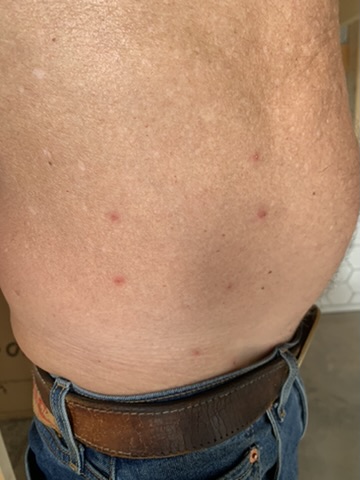

BUG BITES, ONE CULPRIT IS A MOSQUITO, THE OTHER CHIGGERS. CAN YOU TELL THE DIFFERENCE?
Most of us don’t distinguish the difference between the two by looking at the Bite. A third nasty biter, a true bloodsucker, is the tick. You can distinguish the tick from the other two because it is generally attached to the skin busily taking in nourishment.
Whether hiking, fishing, camping, hunting, or anytime you are outdoors there is a chance these three biters are lurking around. They all habit wooded areas, grasslands, and locations with heavy vegetation, such as your yard. Of these three, only mosquitos fly, the other two will attempt to attach to you as you walk through their territory. All three are found worldwide.
MOSQUITOES feed on the blood of animals. They are well known to carry and transmit several diseases including, West Nile virus, malaria, dengue fever, yellow fever, and encephalitis.
CHIGGERS are extremely small and red or orange in color. They do not burrow into your skin as was previously assumed and only the larvae feed on the skin. The larvae will inject a digestive enzyme into to the skin to break down the cells for their feeding pleasure. This causes intense itching and irritation.
TICKS are true bloodsuckers and are well known for transmitting diseases such as Lyme disease, Rocky Mountain Spotted fever and tick-borne encephalitis.
As you enjoy outdoor activities, keep these tiny creatures in mind and protect yourself and your family.
Reduce breeding sites for mosquitoes by eliminating stagnant water sources. Do you leave a pet’s water bowl out at night? Dump it out, wipe out the bowl and fill with fresh water in the morning. If your pet lives outdoors, be sure to fill with fresh water frequently.
Spray your yard with pet and human safe products to eliminate as many biting insects as possible. If you are going to be in the woods enjoying outdoor activities apply insect repellents containing DEET or permethrin. If you get bites, use soap and water to thoroughly clean the area. Apply anti-itch cream to soothe the itch. And, in the case of ticks, carefully remove the tick with tweezers, wash the area and as a secondary precaution use peroxide. If the tick has been attached for more than 48 hours, you should see your doctor.
Did you know, ARKANSAS is home to seven species of ticks: Gulf Coast Tick, Rocky Mountain Spotted Fever tick, Deer Tick, American Dog Tick, Brown Dog Tick, Lone Star Tick (escaped from Texas?), Groundhog Tick, and as the locals here have been quick to tell us, the Seed Tick, which is about the size of a speck of pepper.
Enjoy your outdoor adventures and protect yourself from these tiny creatures.
